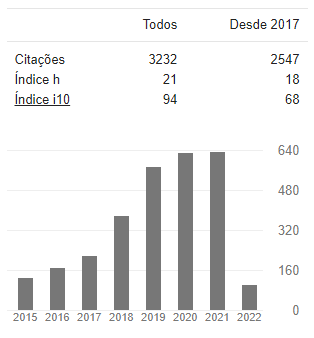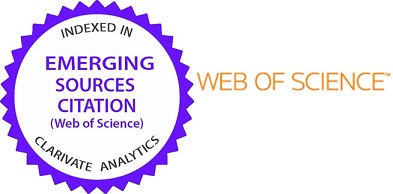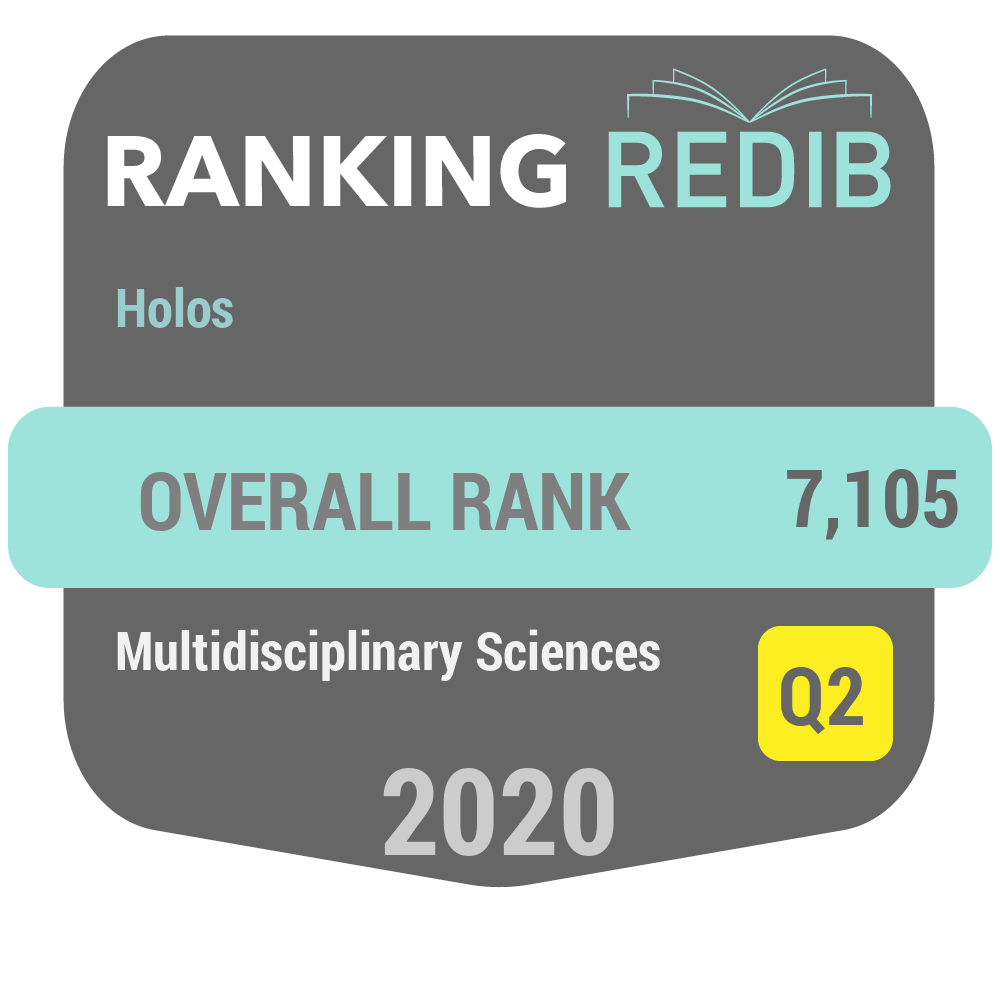MICROPLÁSTICOS EM ÁGUA DOCE: CARACTERIZAÇÃO, FONTES E IMPACTOS
DOI:
https://doi.org/10.15628/holos.2024.16150Palavras-chave:
Poluição, Microplásticos, Impactos Ambientais, Corpos HídricosResumo
Trabalhos sobre a presença de microplásticos (MPs) em ambientes de água doce vêm ganhando espaço desde 2015. Com isso, esta revisão teve como objetivo elaborar panorama sobre a poluição de ambientes de água doce por MPs. Foi utilizada a base de dados Web of Science (palavras-chave microplástico e água doce) de 2015 a 2023. Os resultados obtidos mostram que os MPs têm menos de cinco milímetros, são expressos em itens/L, seus constituintes mais comuns são polipropileno e polietileno, e fibras são o formato mais comum. As principais fontes referem-se ao lançamento de efluentes domésticos e às atividades industriais. O conhecimento sobre o impacto na saúde humana é limitado. Há efeitos tóxicos na biota e os MPs transportam outros poluentes. Ainda é necessário que as pesquisas avancem para preencher lacunas observadas, para que se tenha um panorama mais completo para futuros estudos e ações para a conservação desses ambientes.
Downloads
Referências
AJAY, K., BEHERA, D., BHATTACHARYA, S., MISHRA, P. K., ANKIT, Y., ANOOP, A. (2021). Distribution and characteristics of microplastics and phthalate esters from a freshwater lake system in Lesser Himalayas. Chemosphere, 283, 131132. https://doi.org/10.1016/j.chemosphere.2021.131132
ANDRADY, A. L. (2011). Microplastics in the marine environment. Marine Pollution Bulletin, 62(8), 1596-1605. http://doi.org/10.1016/j.marpolbul.2011.05.030
ARIA, M. & CUCCURULLO, C. (2017). Bibliometrix: An R-tool for comprehensive science mapping analysis, Journal of Informetrics, 11(4), 959-975. https://doi.org/10.1016/j.joi.2017.08.007
AVIO, C. G., GORBI, S. & REGOLI, F. (2017). Plastics and microplastics in the oceans: from emerging pollutants to emerged threat. Marine Environmental Research, 128, 2-11. http://doi.org/10.1016/j.marenvres.2016.05.012
AZZARELLO, M. Y. & VAN VLEET, E. (1987). Marine birds and plastic pollution. Marine Ecology Progress Series, v. 37, p.295-303.
BERTOLDI, C., LARA, L. Z., MIZUSHIMA, F. A. L., MARTINS, F. C. G., BATTISTI, M. A., HINRICHS, R. & FERNANDES, A. N. (2021). First evidence of microplastic contamination in the freshwater of Lake Guaíba, Porto Alegre, Brazil. Science of the Total Environment, 759, 143503. http://doi.org/10.1016/j.scitotenv.2020.143503
BOTELHO, M. J., VALE, C., MARQUES, F., MOREIRINHA, C., SILVIO, LÚCIA GUILHERMINO, JOAQUIM, S., MATIAS, D., M. CANDEIAS, & RUDNITSKAYA, A. (2023). One-year variation in quantity and properties of microplastics in mussels (Mytilus galloprovincialis) and cockles (Cerastoderma edule) from Aveiro lagoon. Environmental Pollution, 333, 121949–121949. https://doi.org/10.1016/j.envpol.2023.121949
BOYLE, K. & ÖRMECI, B. (2020). Microplastics and nanoplastics in the freshwater and terrestrial environment: a review. Water, 12(9), 2633. http://doi.org/10.3390/w12092633
BRAUN, T., EHRLICH, L., HENRICH, W., KOEPPEL, S., LOMAKO, I., SCHWABL, P. & LIEBMANN, B. (2021). Detection of microplastic in human placenta and meconium in a clinical setting. Pharmaceutics, 13(7), p. 921. http://doi.org/10.3390/pharmaceutics13070921
CASTRO, G., BERNEGOSSI, A. C., PINHEIRO, F. R., FELIPE, M. C. & CORBI, J. J. (2020). Effects of Polyethylene Microplastics on Freshwater Oligochaeta Allonais inaequalis (Stephenson, 1911) Under Conventional and Stressful Exposures. Water, Air, Soil Pollut, 231(9), 1-13. https://doi.org/10.1007/s11270-020-04845-y
CERA, A., CESARINI, G. & SCALICI, M. (2020). Microplastics in freshwater: what is the news from the world? Diversity, 12(7), 276. http://doi.org/10.3390/d12070276
CHEN, C., LU, T., YANG, Y. & LIAO, C. (2021). Toxicokinetic/toxicodynamic-based risk assessment of freshwater fish health posed by microplastics at environmentally relevant concentrations. Science of the Total Environment, 756, 144013. http://doi.org/10.1016/j.scitotenv.2020.144013
CHEN, X., CHEN, X., ZHAO, Y., ZHOU, H., XIONG, X. & WU, C. (2020). Effects of microplastic biofilms on nutrient cycling in simulated freshwater systems. Science of the Total Environment, 719, 137276. http://doi.org/10.1016/j.scitotenv.2020.137276
CONNORS, P. G. & SMITH, K. G. (1982). Oceanic plastic particle pollution: suspected effect on fat deposition in red phalaropes. Marine Pollution Bulletin, 13(1), 18-20, 1982. Retrieved December 30, 2021, from Available online at: https://www.sciencedirect.com/science/article/abs/pii/0025326X82904
COSTA, D. A., JUNIOR, L. C. S. S., AZEVEDO, J. P. S., SANTOS, M. A. & ASSUMPÇÃO, R. S. F. V. (2021). From Monitoring and Modeling to Management: how to improve water quality in Brazilian rivers? a case study. Water, 13(2), 176. https://doi.org/10.3390/w13020176
COSTA, D. A., AZEVEDO, J. P. S., SANTOS, M. A. & ASSUMPÇÃO, R. S. F. V. (2020). Water quality assessment based on multivariate statistics and water quality index of a strategic river in the Brazilian Atlantic Forest. Scientific Reports, 10(1), 1-13. https://doi.org/10.1038/s41598-020-78563-0
DOMOGALLA-URBANSKY, J., ANGER, P. M., FERLING, H., RAGER, F., WIESHEU, A. C., NIESSNER, R., IVLEVA, N. P. & SCHWAIGER, J. (2018). Raman microspectroscopic identification of microplastic particles in freshwater bivalves (Unio pictorum) exposed to sewage treatment plant effluents under different exposure scenarios. Environmental Science and Pollution Research, 26, 2007-2012. http://doi.org/10.1007/s11356-018-3609-3
DONG, Y., GAO, M., QIU, W. & SONG, Z. (2021). Effects of microplastic on arsenic accumulation in Chlamydomonas reinhardtii in a freshwater environment. Journal of Hazardous Materials, 405, 124232. http://doi.org/10.1016/j.jhazmat.2020.124232
EERKES-MEDRANO, D., THOMPSON, R. C. & ALDRIDGE, D. C. (2015). Microplastics in freshwater systems: a review of the emerging threats, identification of knowledge gaps and prioritisation of research needs. Water Research, 75, 63-82. http://doi.org/10.1016/j.watres.2015.02.012
EHLERS, S., MANZ, W. & KOOP, J. (2019). Microplastics of different characteristics are incorporated into the larval cases of the freshwater caddisfly Lepidostoma basale. Aquatic Biology, 28, 67-77. http://doi.org/10.3354/ab00711
ERDOGAN, S. (2020). Microplastic pollution in freshwater ecosystems: a case study from turkey. Ege Journal of Fisheries and Aquatic Sciences, 37(3), 213-221. http://doi.org/10.12714/egejfas.37.3.02
GAO, H., YAN, C., LIU, Q., DING, W., CHEN, B. & LI, Z. (2019). Effects of plastic mulching and plastic residue on agricultural production: a meta-analysis. Science of the Total Environment, 651, 484-492. http://doi.org/10.1016/j.scitotenv.2018.09.105
GARCIA, F., CARVALHO, A. R., RIEM-GALLIANO, L., TUDESQUE, L., ALBIGNAC, M., HALLE, A. & CUCHEROUSSET, J. (2021). Stable Isotope Insights into Microplastic Contamination within Freshwater Food Webs. Environmental Science & Technology, 55(2), 1024-1035. http://doi.org/10.1021/acs.est.0c06221
GEISSEN, V., MOL, H., KLUMPP, E., UMLAUF, G., NADAL, M., PLOEG, M., ZEE, S. E. A. T. M. & RITSEMA, C. J. (2015). Emerging pollutants in the environment: a challenge for water resource management. International Soil and Water Conservation Research, 3(1), 57-65. http://doi.org/10.1016/j.iswcr.2015.03.002
GONZÁLEZ-PLEITER, M., EDO, C., VELÁZQUEZ, D., CASERO-CHAMORRO, M. C., LEGANÉS, F., QUESADA, A., FERNÁNDEZ-PIÑAS, F. & ROSAL, R. (2020). First detection of microplastics in the freshwater of an Antarctic Specially Protected Area. Marine Pollution Bulletin, 161, 111811. http://doi.org/10.1016/j.marpolbul.2020.111811
GUIMARÃES, A. T. B., CHARLIE-SILVA, I. & MALAFAIA, G. (2021). Toxic effects of naturally-aged microplastics on zebrafish juveniles: a more realistic approach to plastic pollution in freshwater ecosystems. Journal of Hazardous Materials, 407, 124833. http://doi.org/10.1016/j.jhazmat.2020.124833
HOSSAIN, M. R., JIANG, M., WEI, Q. & LEFF, L. G. (2018). Microplastic surface properties affect bacterial colonization in freshwater. Journal of Basic Microbiology, 59(1), 54-61. http://doi.org/10.1002/jobm.201800174
JAMBECK, J. R., GEYER, R., WILCOX, C., SIEGLER, T. R., PERRYMAN, M., ANDRADY, A., NARAYAN, R. & LAW, K. L. (2015). Plastic waste inputs from land into the ocean. Science, 347(6223),768-771. http://doi.org/10.1126/science.1260352
JEMEC, A., HORVAT, P., KUNEJ, U., BELE, M. & KRZAN, A. (2016). Uptake and effects of microplastic textile fibers on freshwater crustacean Daphnia magna. Environmental Pollution, 219, 201-209. http://doi.org/10.1016/j.envpol.2016.10.037
KALOYIANNI, M., BOBORI, D. C., XANTHOPOULOU, D., MALIOUFA, G., SAMPSONIDIS, I., KALOGIANNIS, S., FEIDANTSIS, K., KASTRINAKI, G., DIMITRIADI, A., KOUMOUNDOUROS, G., LAMBROPOULOU, D. A., KYZAS, G. Z. & BIKIARIS, D. N. (2021). Toxicity and Functional Tissue Responses of Two Freshwater Fish after Exposure to Polystyrene Microplastics. Toxics, 9, 289. http://doi.org/10.3390/toxics9110289
KASAMESIRI, P., MEKSUMPUN, C., MEKSUMPUN, S. & RUENGSORN, C. (2021). Assessment on microplastics contamination in freshwater fish: a case study of the ubolratana reservoir, thailand. International Journal of Geomate, 20(77), 62-68. http://doi.org/10.21660/2020.77.6108
KARUPPASAMY, M. B., SRINIVASALU, S., USHA, N., RAMAMOORTHY, A., NIRMAL, K. S., ANBALAGAN, S., SUJATHA, K. & ALAGARASAN, C. (2021). Microplastics as an emerging threat to the freshwater ecosystems of Veeranam lake in south India: a multidimensional approach. Chemosphere, 264(2), 128502. https://doi.org/10.1016/j.chemosphere.2020.128502
KIM, L., KIM, D., KIM., S. A., KIM, H., LEE, T. Y. & AN, Y. J. (2022). Are your shoes safe for the environment? – Toxicity screening of leachates from microplastic fragments of shoe soles using freshwater organisms. Journal of Hazardous Materials, 421, 126779-126788. https://doi.org/10.1016/j.jhazmat.2021.126779
KUŚMIEREK, N., POPIOłEK, M. (2020). Microplastics in freshwater fish from Central European lowland river (Widawa R., SW Poland). Environmental Science and Pollution Research, 27(10), 11438-11442. http://doi.org/10.1007/s11356-020-08031-9
LAGARDE, F., OLIVIER, O., ZANELLA, M., DANIEL, P., HIARD, S. & CARUSO, A. (2016). Microplastic interactions with freshwater microalgae: hetero-aggregation and changes in plastic density appear strongly dependent on polymer type. Environmental Pollution, 215, 331-339. http://doi.org/10.1016/j.envpol.2016.05.006
LI, C., BUSQUETS, R. & CAMPOS, L. C. (2020). Assessment of microplastics in freshwater systems: a review. Science of The Total Environment, 707, 135578. http://doi.org/10.1016/j.scitotenv.2019.135578
LI, J., LIU, H. & CHEN, J. P. (2018). Microplastics in freshwater systems: a review on occurrence, environmental effects, and methods for microplastics detection. Water Research, 137, 362-374. http://doi.org/10.1016/j.watres.2017.12.056
MARTINEZ-TAVERA, E., DUARTE-MORO, A. M., RODRIGUEZ-ESPINOSA, P. F., ROSANO-ORTEGA, G. & EXPÓSITO, N. (2021). Microplastics and metal burdens in freshwater Tilapia (Oreochromis niloticus) of a metropolitan reservoir in Central Mexico: potential threats for human health. Chemosphere, 266, 128968. http://doi.org/10.1016/j.chemosphere.2020.128968
MARTINS, A. & GUILHERMINO, L. (2018). Transgenerational effects and recovery of microplastics exposure in model populations of the freshwater cladoceran Daphnia magna Straus. Science of the Total Environment, 631, 421-428. http://doi.org/10.1016/j.scitotenv.2018.03.054.
MENDOZA, L. M. R. & BALCER, M. (2019). Microplastics in freshwater environments: a review of quantification assessment. Trac Trends in Analytical Chemistry, 113, 402-408. http://doi.org/10.1016/j.trac.2018.10.020
MENG, Y., KELLY, F. J. & WRIGHT, S. L. (2020). Advances and challenges of microplastic pollution in freshwater ecosystems: a uk perspective. Environmental Pollution, 256, 113445. http://doi.org/10.1016/j.envpol.2019.113445
METCALF, R., WHITE, H. L., ORMSBY, M. J., OLIVER, D. M., & QUILLIAM, R. S. (2023). From wastewater discharge to the beach: Survival of human pathogens bound to microplastics during transfer through the freshwater-marine continuum. Environmental Pollution, 319, 120955. https://doi.org/10.1016/j.envpol.2022.120955.
MIAO, L., YU, Y., ADYEL, T. M., WANG, C., LIU, Z., LIU, S., HUANG, L., YOU, G., MENG, M., QU, H. & HOU, J. (2021). Distinct microbial metabolic activities of biofilms colonizing microplastics in three freshwater ecosystems. Journal of Hazardous Materials, 403, 123577. https://doi.org/10.1016/j.jhazmat.2020.123577
MILOLOŽA, M., KUČIĆ GRGIĆ, D., BOLANČA, T., UKIĆ, Š., CVETNIĆ, M., OCELIĆ BULATOVIĆ, V., DIONYSIOU, D. D. & KUŠIĆ, H. (2021). Ecotoxicological assessment of microplastics in freshwater Sources - a review. Water, 13(1), 56. http://doi.org/10.3390/w13010056
MOLAZADEH, M., LIU, F., SIMON-SÁNCHEZ, L., & VOLLERSTEN, J. (2023). Buoyant microplastics in freshwater sediments – How do they get there? Science of the Total Environment, 860, 160489. https://doi.org/10.1016/j.scitotenv.2022.160489
MOORE; C. J., LATTIN, G. L. & ZELLERS, A. F. (2011). Quantity and type of plastic debris flowing from two urban rivers to coastal waters and beaches of Southern California. Journal of Integrated Coastal Zone Management, 11(1), 65-73. http://doi.org/10.5894/rgci194
NAN, B., SU, L., KELLAR, C., CRAIG, N. J., KEOUGH, M. J. & PETTIGROVE, V. (2020). Identification of microplastics in surface water and Australian freshwater shrimp Paratya australiensis in Victoria, Australia. Environmental Pollution, 259, 113865. http://doi.org/10.1016/j.envpol.2019.113865
NG, K.L. & OBBARD, J.P. (2006). Prevalence of microplastics in Singapore’s coastal marine environment. Marine Pollution Bulletin, 52(7), 761-767. http://doi.org/10.1016/j.marpolbul.2005.11.017
OLIVEIRA, P., BARBOZA, L. G. A., BRANCO, V., FIGUEIREDO, N., CARVALHO, C. & GUILHERMINO, L. (2018). Effects of microplastics and mercury in the freshwater bivalve Corbicula fluminea (Müller, 1774): filtration rate, biochemical biomarkers and mercury bioconcentration. Ecotoxicology and Environmental Safety, 164, 155-163. http://doi.org/10.1016/j.ecoenv.2018.07.062
PARKER, B., ANDREOU, D., GREEN, I. D. & BRITTON, J. R. (2021). Microplastics in freshwater fishes: occurrence, impacts and future perspectives. Fish and Fisheries, 22(3), 467-488. http://doi.org/10.1111/faf.12528
PAZOS, R. S., MAIZTEGUI, T., COLAUTTI, D. C., PARACAMPO, A. H. & GÓMEZ, N. (2017). Microplastics in gut contents of coastal freshwater fish from Río de la Plata estuary. Marine Pollution Bulletin, 122(1-2), 85-90. http://doi.org/10.1016/j.marpolbul.2017.06.007
PICO, Y., ALFARHAN, A. & BARCELO, D. (2019). Nano- and microplastic analysis: focus on their occurrence in freshwater ecosystems and remediation technologies. Trac Trends in Analytical Chemistry, 113, 409-425. http://doi.org/10.1016/j.trac.2018.08.022
RANI-BORGES, B., MOSCHINI-CARLOS, V. & POMPÊO, M. (2021). Microplastics and freshwater microalgae: what do we know so far? Aquatic Ecology, [S. l.], 55(2), p. 363-377. http://doi.org/10.1007/s10452-021-09834-9
RODRIGUES, M. O., ABRANTES, N., GONÇALVES, F. J. M., NOGUEIRA, H., MARQUES, J. C. & GONÇALVES, A. M. M. (2018). Spatial and temporal distribution of microplastics in water and sediments of a freshwater system (Antuã River, Portugal). Science of the Total Environment, 633, 1549-1559. http://doi.org/10.1016/j.scitotenv.2018.03.233
ROTHSTEIN, S. I. (1973). Particle pollution of the surface of the Atlantic Ocean: evidence from a seabird. The Condor, 75(3), 344-345.
SAIT, S. T. L., SØRENSEN, L., KUBOWICZ, S., VIKE-JONAS, K., GONZALEZ, S. V., ASIMAKOPOULOS, A. G. & BOOTH, A. M. (2021). Microplastic fibres from synthetic textiles: environmental degradation and additive chemical content. Environmental Pollution, 268, 115745. http://doi.org/10.1016/j.envpol.2020.115745
SÁNCHEZ-FORTUN, A., FAJARDO, C., MARTÍN, C., D’ORS, A., NANDE, M., MENGS, G., COSTA, G., MARTÍN, M. & SÁNCHEZ-FORTÚN, S. (2021). Effects of polyethylene-type microplastics on the growth and primary production of the freshwater phytoplankton species Scenedesmus armatus and Microcystis aeruginosa. Environmental and Experimental Botany, 188, 104510. https://doi.org/10.1016/j.envexpbot.2021.104510
SARIJAN, S., AZMAN, S., SAID, M. I. M. & JAMAL, M. H. (2020). Microplastics in freshwater ecosystems: a recent review of occurrence, analysis, potential impacts, and research needs. Environmental Science and Pollution Research, 28(2), p. 1341-1356. http://doi.org/10.1007/s11356-020-11171-7
SCOTT, P. G. (1972). Plastics packaging and coastal pollution. International Journal of Environmental Studies, 3(1-4), 35-36.
STRADY, E., DANG, T. H., DAO, T. D., DINH, H. N., DO, T. T. D., DUONG, T. N., DUONG, T. T., HOANG, D. A., KIEU-LE, T. C., LE, T. P. Q., MAI, H., TRINH, D. M., NGUYEN, Q. H., TRAN-NGUYEN, Q. A., TRAN, Q. V., TRUONG, T. N. S., CHU, V. H. & VO, V. C. (2021). Baseline assessment of microplastic concentrations in marine and freshwater environments of a developing Southeast Asian country, Viet Nam. Marine Pollution Bulletin, 162, 111870. http://doi.org/10.1016/j.marpolbul.2020.111870
STRAUB, S., HIRSCH, P. E. & BURKHARDT-HOLM, P. (2017). Biodegradable and petroleum-based microplastics do not differ in their ingestion and excretion but in their biological effects in a freshwater invertebrate gammarus fossarum. International Journal of Environmental Research and Public Health, 14(7), 774. http://doi.org/10.3390/ijerph14070774
SUN, D., WANG, J., XIE, S., TANG, H., ZHANG, C., XU, G., ZOU, J., ZHOU, A. (2021). Characterization and spatial distribution of microplastics in two wild captured economic freshwater fish from north and west rivers of Guangdong province. Ecotoxicology and Environmental Safety, 207, 111555. http://doi.org/10.1016/j.ecoenv.2020.111555
SZYMAŃSKA, M. & OBOLEWSKI, K. (2020). Microplastics as contaminants in freshwater environments: a multidisciplinary review. Ecohydrology & Hydrobiology, 20(3), 333-345. http://doi.org/10.1016/j.ecohyd.2020.05.001
TRIEBSKORN, R., BRAUNBECK, T., GRUMMT, T., HANSLIK, L., HUPPERTSBERG, S., JEKEL, M., KNEPPER, T. P., KRAIS, S., MÜLLER, Y. K., PITTROFF, M., RUHL, A. S., SCHMIEG, H., SCHÜR, C., STROBEL, C., WAGNER, M., ZUMBÜLTE, N. & KÖHLER, H. (2019). Relevance of nano- and microplastics for freshwater ecosystems: a critical review. Trac Trends in Analytical Chemistry, 110, 375-392. http://doi.org/10.1016/j.trac.2018.11.023
TUMWESIGYE, E., CHIKA FELICITAS NNADOZIE, AKAMAGWUNA, F. C., XAVIER SIWE NOUNDOU, GEORGE WILLIAM NYAKAIRU, & OGHENEKARO NELSON ODUME. (2023). Microplastics as vectors of chemical contaminants and biological agents in freshwater ecosystems: Current knowledge status and future perspectives. Environmental Pollution, 330, 121829–121829. https://doi.org/10.1016/j.envpol.2023.121829
VERDÚ, I., GONZÁLEZ-PLEITER, M., LEGANÉS, F., ROSAL, R., FERNÁNDEZ-PIÑAS, F. (2021). Microplastics can act as vector of the biocide triclosan exerting damage to freshwater microalgae. Chemosphere, 266, 129193. http://doi.org/10.1016/j.chemosphere.2020.129193
WANG, Z., QIN, Y., LI, W., YANG, W., MENG, Q. & YANG, J. (2019). Microplastic contamination in freshwater: first observation in lake Ulansuhai, yellow river Basin, China. Environmental Chemistry Letters, 17(4), 1821-1830. http://doi.org/10.1007/s10311-019-00888-8
WARDLAW, C. & PROSSER, R. S. (2020). Investigation of Microplastics in Freshwater Mussels (Lasmigona costata) From the Grand River Watershed in Ontario, Canada. Water, Air, & Soil Pollution, 231(8), 1-14. http://doi.org/10.1007/s11270-020-04741-5
WEBER, A., JECKEL, N. & WAGNER, M. (2020). Combined effects of polystyrene microplastics and thermal stress on the freshwater mussel Dreissena polymorpha. Science of the Total Environment, 718, 137253. http://doi.org/10.1016/j.scitotenv.2020.137253
WONG, J. K. H., LEE, K. K., TANG, K. H. D. & YAP, P. (2020). Microplastics in the freshwater and terrestrial environments: prevalence, fates, impacts and sustainable solutions. Science of the Total Environment, 719, 137512. http://doi.org/10.1016/j.scitotenv.2020.137512
WU, L.; ZHU, Z., LIANG, Y. & ZHANG, F. (2001). Plastic film mulching cultivation: a new technology for resource saving water N fertiliser and reduced environmental pollution. Plant Nutrition, 92, 1024-1025. https://doi.org/10.1007/0-306-47624-X_499
WU, X., WU, H., ZHANG, A., SEKOU, K., LI, Z. & YE, J. (2022). Influence of polystyrene microplastics on levofloxacin removal by microalgae from freshwater aquaculture wastewater. Journal of Environmental Management, 301, 113865-113872. https://doi.org/10.1016/j.jenvman.2021.113865
ZHANG, L., XIE, Y., ZHONG, S., LIU, J., QIN, Y. & GAO, P. (2021). Microplastics in freshwater and wild fishes from Lijiang River in Guangxi, Southwest China. Science of the Total Environment, 755, 142428. http://doi.org/10.1016/j.scitotenv.2020.142428
ZHAO, S., ZHU, L., WANG, T., LI, D. (2014). Suspended microplastics in the surface water of the Yangtze Estuary System, China: first observations on occurrence, distribution. Marine Pollution Bulletin, 86, 1-2, 562-568. http://doi.org/10.1016/j.marpolbul.2014.06.032.
Downloads
Publicado
Como Citar
Edição
Seção
Licença

Este trabalho está licenciado sob uma licença Creative Commons Attribution-NonCommercial-NoDerivatives 4.0 International License.









































